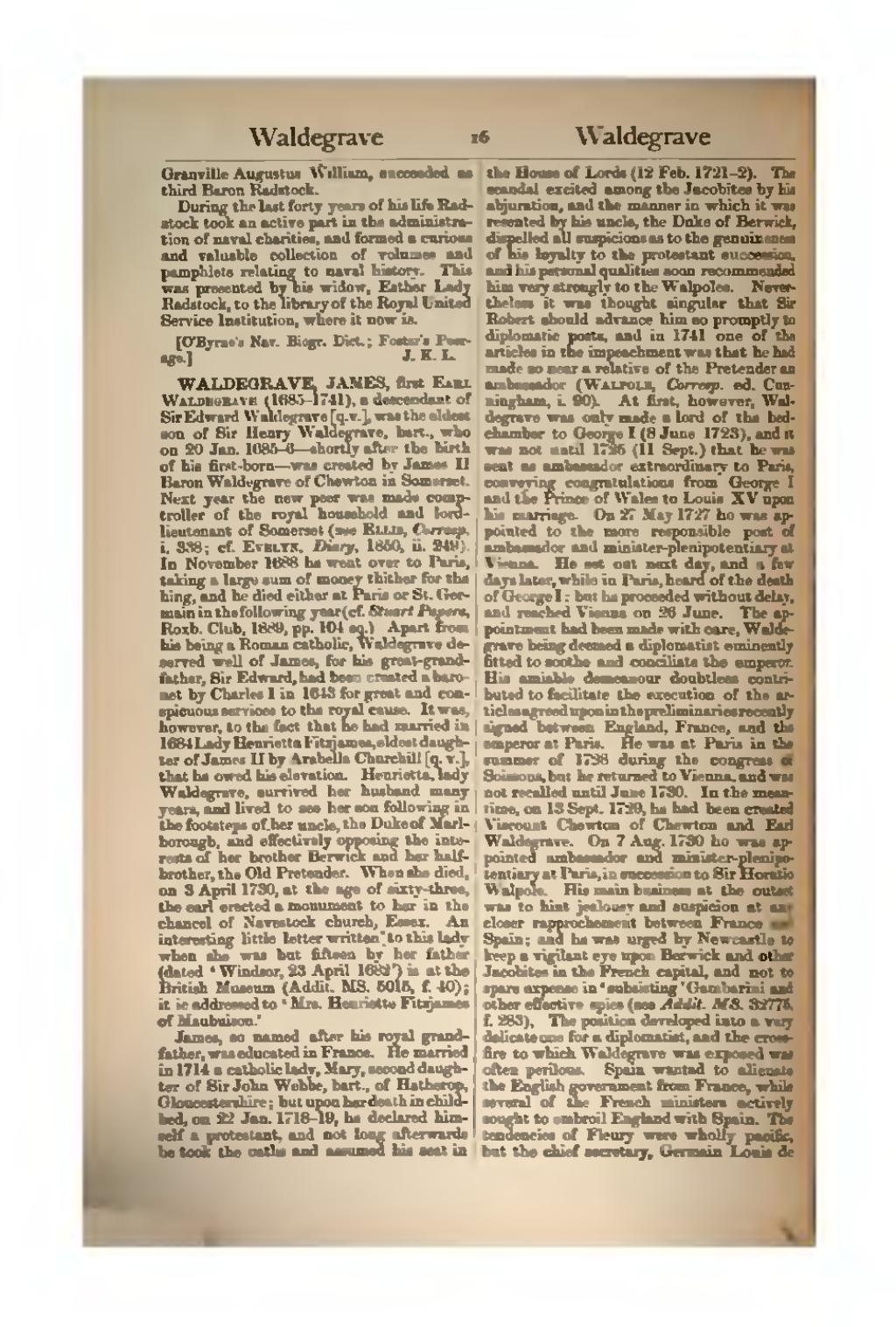Granville Augustus William, succeeded as third Baron Radstock. During the last forty years of his life Radstock took an active part in the administration of naval charities, and formed a curious and valuable collection of volumes and pamphlets relating to naval history. This was presented by his widow, Esther Lady Radstock, to the library of the Royal United Service Institution, where it now is.
[O'Byrne's Nav. Biogr. Dict.; Foster's Peerage.]
WALDEGRAVE, JAMES, first Earl Waldegrave (1685–1741), a descendant of Sir Edward Waldegrave [q. v.], was the eldest son of Sir Henry Waldegrave, bart., who on 20 Jan. 1685–6—shortly after the birth of his first-born—was created by James II Baron Waldegrave of Chewton in Somerset. Next year the new peer was made comptroller of the royal household and lord-lieutenant of Somerset (see Ellis, Corresp. i. 338; cf. Evelyn, Diary, 1850, ii. 249). In November 1688 he went over to Paris, taking a large sum of money thither for the king, and he died either at Paris or St. Germain in the following year (cf. Stuart Papers, Roxb. Club, 1889, pp. 104 sq.). Apart from his being a Roman catholic, Waldegrave deserved well of James, for his great-grandfather, Sir Edward, had been created a baronet by Charles I in 1643 for great and conspicuous services to the royal cause. It was, however, to the fact that he had married in 1684 Lady Henrietta Fitzjames, eldest daughter of James II by Arabella Churchill [q. v.], that he owed his elevation. Henrietta, lady Waldegrave, survived her husband many years, and lived to see her son following in the footsteps of her uncle, the Duke of Marlborough, and effectively opposing the interests of her brother Berwick and her half-brother, the Old Pretender. When she died, on 3 April 1730, at the age of sixty-three, the earl erected a monument to her in the chancel of Navestock church, Essex. An interesting little letter written to this lady when she was but fifteen by her father (dated ‘Windsor, 23 April 1682’) is at the British Museum (Addit. MS. 5015, f. 40); it is addressed to ‘Mrs. Henriette Fitzjames of Maubuison.’
James, so named after his royal grandfather, was educated in France. He married in 1714 a catholic lady, Mary, second daughter of Sir John Webbe, bart., of Hatherop, Gloucestershire; but upon her death in childbed, on 22 Jan. 1718–19, he declared himself a protestant, and not long afterwards he took the oaths and assumed his seat in the House of Lords (12 Feb. 1721–2). The scandal excited among the Jacobites by his abjuration, and the manner in which it was resented by his uncle, the Duke of Berwick, dispelled all suspicions as to the genuineness of his loyalty to the protestant succession, and his personal qualities soon recommended him very strongly to the Walpoles. Nevertheless it was thought singular that Sir Robert should advance him so promptly to diplomatic posts, and in 1741 one of the articles in the impeachment was that he had made so near a relative of the Pretender an ambassador (Walpole, Corresp. ed. Cunningham, i. 90). At first, however, Waldegrave was only made a lord of the bedchamber to George I (8 June 1723), and it was not until 1725 (11 Sept.) that he was sent as ambassador extraordinary to Paris, conveying congratulations from George I and the Prince of Wales to Louis XV upon his marriage. On 27 May 1727 he was appointed to the more responsible post of ambassador and minister-plenipotentiary at Vienna. He set out next day, and a few days later, while in Paris, heard of the death of George I; but he proceeded without delay, and reached Vienna on 26 June. The appointment had been made with care, Waldegrave being deemed a diplomatist eminently fitted to soothe and conciliate the emperor. His amiable demeanour doubtless contributed to facilitate the execution of the articles agreed upon in the preliminaries recently signed between England, France, and the emperor at Paris. He was at Paris in the summer of 1728 during the congress of Soissons, but he returned to Vienna, and was not recalled until June 1730. In the meantime, on 13 Sept. 1729, he had been created Viscount Chewton of Chewton and Earl Waldegrave. On 7 Aug. 1730 he was appointed ambassador and minister-plenipotentiary at Paris, in succession to Sir Horatio Walpole. His main business at the outset was to hint jealousy and suspicion at any closer rapprochement between France and Spain; and he was urged by Newcastle to keep a vigilant eye upon Berwick and other Jacobites in the French capital, and not to spare expense in ‘subsisting’ Gambarini and other effective spies (see Addit. MS. 32775, f. 283). The position developed into a very delicate one for a diplomatist, and the crossfire to which Waldegrave was exposed was often perilous. Spain wanted to alienate the English government from France, while several of the French ministers actively sought to embroil England with Spain. The tendencies of Fleury were wholly pacific, but the chief secretary, Germain Louis de
